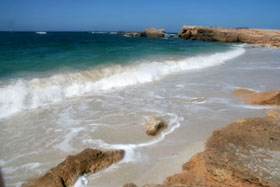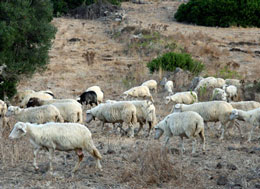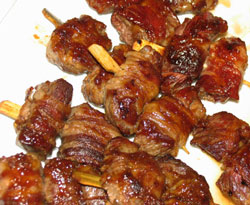WAITING
FOR EXPO 2015
![]() By Enza
Bettelli
By Enza
Bettelli
IGP lamb from Sardinia
 Sardinia
is fascinating, with its wild landscapes, rocky coasts, turquoise sea,
small white beaches. Inland there are woods and glades, and then more
rocks, plateaux and mountains with extensive areas ideal for lamb farming.
Sardinia
is fascinating, with its wild landscapes, rocky coasts, turquoise sea,
small white beaches. Inland there are woods and glades, and then more
rocks, plateaux and mountains with extensive areas ideal for lamb farming.
The punic and roman ruins are very interesting, and so are the remains
from nuragic times, gothic-catalan monuments, prehistoric and protohistoric
remains of the island, as well as more modern monuments such as the square
in Ales dedicated to its famous inhabitant, Antonio Gramsci.
Historical and cultural excursions can be alternated with water sports,
hiking, cycling and horseback riding, or visiting the various fairs and
festivals to get a taste of the local produce from all seasons.

THE COOPERATIVE
Sheep farming is an art which has been practised in Sardinia for thousands
of years. As a matter of fact, the whole island is considered I.G.P. territory,
even though the areas of Cagliari, Nuoro, Oristano, Sassari, Carbonia-Iglesias,
Medio Campidano, Ogliastra, Olbia-Tempio are more well known. The I.G.P.
cooperative for the safeguard of the Sardinian lamb was founded in 2001
and is presently based in Nuoro. The cooperative’s duty is to verify
and guarantee respect for quality by keeping the whole agrarian-food chain
under control by means of a special organization authorized by the Ministry
of Agriculture and managed by a certification committee made up of members
from all parts of the chain, including consumers and scientists.
I.G.P. lamb is sold with the wording Agnello di Sardegna, the I.G.P. mark,
the type of meat and the name of the cut.

THE LAMB
 Only
lambs born, reared and butchered in Sardinia may be considered I.G.P..
Farming is mostly free range, in sunny, open spaces, exposed to the wind,
in completely natural environments where the animals graze freely.
Only
lambs born, reared and butchered in Sardinia may be considered I.G.P..
Farming is mostly free range, in sunny, open spaces, exposed to the wind,
in completely natural environments where the animals graze freely.
The lambs are Sardinian and are divided in three types:
- Milk lambs: cold weight, without
hide 5-7 kg, fed exclusively on their mother’s milk
- Light: cold weight, without
hide 7-10 kg, fed on mother’s milk integrated with fodder and fresh
and/or dried cereals
- Cutting: weight cold and without
hide 10-13 kg, fed with mother’s milk integrated with fodder and
fresh and/or dried cereals
This type of lamb can only be Sardinian, or first generation cross breeds
with Ile De France and Berricon Du Cher or other meat races which are
highly specialized.
GASTRONOMY OF THE TERRITORY
There is fresh fish from the sea, including tuna, lobsters and mullet
from which the precious fish eggs are obtained. There is lamb which is
cooked in various ways but the traditional recipe uses myrtle and rosemary.
These same herbs are also used to flavour the small pigs from which an
excellent number of cold cuts are obtained. There are excellent vegetables
and sheep and goat’s milk which used for various typical cheeses,
such as pecorino, ricotta and other fresh cheeses often used in our cuisine.
Pasta is fresh and sometimes very simple such as ‘sa fregula (very
small balls of flour and water) and malloreddus (very tiny grain dumplings),
seasoned with tomato or minced meat or fish, or richer ones such as cheese
ravioli (angiolottus or culingiones). Frattau bread is a very brittle
puff pastry which lasts for quite a while and is used as a base for typical
soups.
 Almonds and honey
are the base for amaretti, torrone, the soft little frosted balls called
suspirus, sweet ravioli sebadas, pardulas which are small baskets dressed
with ricotta, and so on.
Almonds and honey
are the base for amaretti, torrone, the soft little frosted balls called
suspirus, sweet ravioli sebadas, pardulas which are small baskets dressed
with ricotta, and so on.
Local saffron flavours and colours dishes and desserts and is very typical
of the area, as is the excellent olive oil. There is an abundance of wine
to match; among which Vernaccia, Malvasia and Cannonau being the most
famous.
LAMB KEBABS
 These are small bite-sized pieces of lamb, wrapped in lard and put on
reed or wood kebab sticks. They are lined up in a pan, previously greased
with oil. Rosemary and myrtle twigs are added, as well as crushed garlic
if desired, and more oil is brushed over the kebabls. Salt and pepper
is added and the kebabs are cooked on a moderate heat, turned over frequently,
for about 15 minutes or until the meat has become a nice golden colour.
Myrtle may be substituted with fresh wild fennel twigs.
These are small bite-sized pieces of lamb, wrapped in lard and put on
reed or wood kebab sticks. They are lined up in a pan, previously greased
with oil. Rosemary and myrtle twigs are added, as well as crushed garlic
if desired, and more oil is brushed over the kebabls. Salt and pepper
is added and the kebabs are cooked on a moderate heat, turned over frequently,
for about 15 minutes or until the meat has become a nice golden colour.
Myrtle may be substituted with fresh wild fennel twigs.
(English translation by Gudrun Dalla Via)
![]()
![]() Back to Waiting for EXPO 2015
Back to Waiting for EXPO 2015